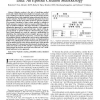1750 search results - page 345 / 350 » Abduction in Classification Tasks |
MP
2008
13 years 8 months ago
2008
We consider derivative free methods based on sampling approaches for nonlinear optimization problems where derivatives of the objective function are not available and cannot be dir...
SIGIR
2008
ACM
13 years 8 months ago
2008
ACM
Searching for people on the Web is one of the most common query types to the web search engines today. However, when a person name is queried, the returned webpages often contain ...
TITB
2008
13 years 8 months ago
2008
Episode creation is the task of classifying medical events and related clinical data to high-level concepts, such as diseases. Challenges in episode creation result in part because...
BMCBI
2005
13 years 8 months ago
2005
Background: Structural and functional research often requires the computation of sets of protein structures based on certain properties of the proteins, such as sequence features,...
BMCBI
2004
13 years 8 months ago
2004
Background: Hidden Markov Models (HMMs) have proven very useful in computational biology for such applications as sequence pattern matching, gene-finding, and structure prediction...

